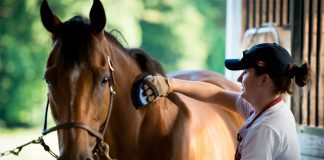
Growth Formula
Experts are divided on whether or not to brush tails. Some professional grooms use only their fingers and wouldn’t be caught dead combing or brushing out a tail. Others say a brush is fine, but never use a comb. Still others think either a brush or comb is fine but must be used carefully.
Although it is possible to fake a great tail in the show-ring with the use of extensions, this is a little high-maintenance for an everyday look.
“I always encourage owners to pay attention to their horse’s tail and grow a naturally thick one,” says Lynn Palm, whose Fox Grove Farm is located in Ocala, Fla. A long-time clinician with a successful competition record, Palm has won nearly three dozen American Quarter Horse Association (AQHA) world and reserve world championships. The 2007 AQHA Horsewoman of the Year, Palm has a record four AQHA Superhorse wins and is also an AQHA judge.
“Grooming a tail every day is important because it stimulates the roots of the hair, which causes the tail to grow,” says Palm.
While some people won’t use a comb in a tail, Palm finds this acceptable so long as you use a wide-tooth comb and don’t tug. Her preference, however, is a human hairbrush with widely spaced bristles. Whether you use your fingers, a brush or a comb, always start at the bottom of the tail and work your way up. This will keep you from pulling out hairs if you hit a tangle. Spraying a detangling product on the tail first will help.
Palm has noticed improvement in tail growth and thickness by incorporating massage of the tail bone into her daily grooming routine.
“Many people never touch or pay attention to the horse’s tail bone, but this is a good thing to do because you’ll notice anything wrong, such as sores, ticks, or dry, flaky areas of skin,” she says. “To really promote tail growth, you need to massage the roots of the hair. Massage the tail bone itself, and with your hands on either side of the bone, pull on the roots of the hair all the way up and down the tail bone. You want to massage the roots as you pull on the hair. You can also use a hard-bristled brush along the top and bottom of the tail bone.”
To encourage growth, the tail should be kept clean, but that doesn’t mean excessive washing.
“When you start conditioning, shampoo the tail weekly for the first month and then go to once every two weeks,” suggests Palm. “Be sure to rinse thoroughly. If you notice a light gray color or any ‘gummy’ feeling at the base of the tail bone, this means the shampoo wasn’t washed out thoroughly and the hair isn’t clean at the roots.”
Palm uses a conditioner after shampooing, rinsing with warm water, since she feels this conditions the hair better than cold water. Afterward, she applies a leave-in conditioner.
“This will help keep the tail tangle-free so you can brush it without breaking the hairs,” she notes.
Protective Measures
If you’re trying to help your horse grow a longer, healthier tail, protecting those precious strands is key.
“Mud and sun will dry out a tail, so when you put it up and protect it, it will grow,” notes Barb Drake of St. Johns, Mich., who has been manufacturing and selling tail bags and tubes since 2002 as part of her Sleezy Barb Horsewear collection.
“A tail bag is best for short-term use, such as when trailering or when you’re at a show overnight and want to keep the tail clean of manure and shavings,” says Drake.
If using a tail bag, wash and condition the tail first. Then braid the tail, insert it into the bag, and tie the bag in place through the braided hair, just below the tail bone. Tail bags come with two or four ties; which you use is personal preference. Drake cautions against using bags with hook-and-loop closures because tail hairs will get caught in them.
She also advises against using a tail bag for an extended time because it will work against your goals of growing a longer, thicker tail.
“When you braid hair on hair, you get a lot of breakage,” explains Drake. “You only want to do this if you are taking the braid out by the next day.” For long-term tail protection, Drake recommends using a three-piece tail tube.
“When you use the tail tubes, there is no hair-on-hair braiding,” says Drake. “You divide the tail into three sections and insert each section into a tube. Then you braid those tubes together.
“It doesn’t matter if the tail is wet or dry when you do this because it dries quickly in the Lycra tail tubes. Lycra is the material you want to use. Fleece will draw moisture out of the tail and so will cotton, which is why you don’t want to use a cotton sock like some people do.”
Tail Problems
Tail rubbing is a major equine beauty bummer. It drives horse owners crazy to see a beautiful tail rubbed into a sad mess at the top. Beyond breaking hairs, some horses will rub themselves raw. Possible causes behind this problem behavior include dry, itchy skin; parasites (specifically pinworms); and the allergic reaction known as “sweet itch,” caused by hypersensitivity to insects. Soothing shampoo, targeted deworming and ramping up fly control measures are simple solutions to start with in these cases. Other types of skin and contact allergies can cause horses to turn to tail rubbing as well. These cases will likely require diagnosis and medication prescribed by your vet.
A dirty sheath or udder can also result in tail rubbing. Since horses can’t scratch these places, they’ll rub their hind end for relief instead. (Click here for step-by-step instructions on sheath cleaning.)
In addition to careful grooming, a good management program will support healthy hair growth. Your horse needs proper nutrition in order to reach his full potential, starting from the inside out. No matter what type of tail your horse has, the right care can help you make the most of it.
How to Use a Tail Bag
Follow these easy instructions to bag a tail.
- Brush the dry tail smooth. (Braiding wet hair damages the hair and makes it harder to smooth it out.)
- Divide your horse’s tail into three equal sections.
- Use hair gel to make the hair easier to hold on to and to tame loose hairs.
- As you braid, keep even tension on the strands, but don’t make it tight. Just gently pull snug as you go. Hold the hair close to the most recent cross-over to keep it in place.
- Comb the hair with your hand as you go. If you see hair bunching up in places, simply hold the whole braid in one hand while you comb the loose hair with the fingers of your other hand.
- Tie off the ends of the braid with a ponytail holder.
- Insert the braid into the tail bag.
- Weave the top ties of the tail bag through the top of the braid below the tail bone and tie off snugly, just like tying a shoelace. Never tie anything around the tail bone, where it could compromise circulation. A tail bag should be checked frequently to make sure it is safely in place and not doing damage. For long-term growth and tail protection, Drake recommends using a three-piece tail tube instead of a bag.
How to Bang a Horse’s Tail
Trimming the bottom of the tail with a blunt cut (traditionally called “banging”) can help it look thicker and fuller. It also creates a tidy appearance, and keeps the horse from stepping on the tail if it is very long. This grooming technique is standard for sporthorses in dressage, eventing and show jumping, and has also been adopted in many western events.
Depending on the natural length of your horse’s tail, you can bang it just a couple inches above the ground, at the fetlock or 4 to 5 inches from the bottom of the hock.
- You’ll need a pair of clippers or sharp scissors.
- First, brush the tail so it’s smooth and tangle-free.
- Next, have a friend trot your horse so you can observe how he normally carries his tail when moving. Then tie your horse and have your friend loosely hold the tail in the same position as when the horse is in motion.
- Hold the end of the tail with the hairs tightly together. Use the scissors or clippers to cut straight across the ends to achieve a squared-off look.
- Untie your horse and have your friend walk him so you can check the tail’s appearance. It should be square to the ground when the horse is in motion. If necessary, trim the end again to obtain the desired length. Remember, it’s always better to err on the side of caution rather than cut off too much at one time.
Liked this article? Here’s more on tail care:
How to Bang a Horse’s Tail
Tips for Thicker Tails
Barn Basics: Tail Bag Tips
CYNTHIA McFARLAND is an Ocala, Florida-based freelance writer and horse owner. The author of eight books, her latest is Cow-Horse Confidence: A Time-Honored Approach to Stockmanship, co-authored with Martin Black.
This article originally appeared in the May 2014 issue of Horse Illustrated. Click here to subscribe.







interesting info
Great info.